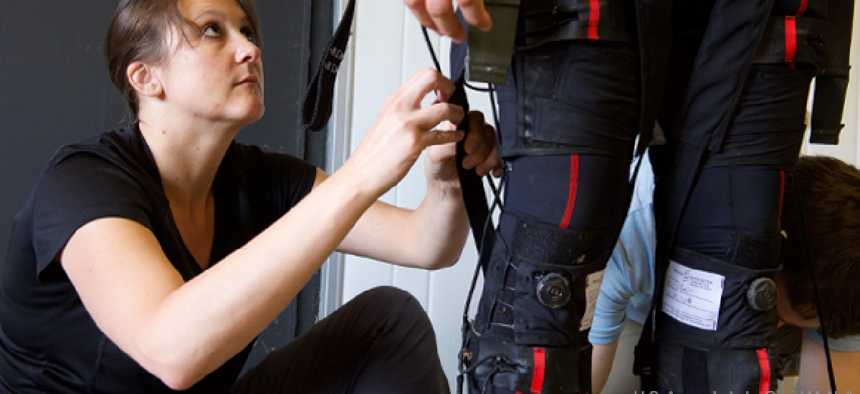Army seeks smarter exoskeletons for soldiers


Connecting state and local government leaders
The EXOSENSE program aims to pull biometric, motion, GPS, temperature and imaging data from exoskeleton sensors and integrate it into both the Android Tactical Assault Kit and Net Warrior situational awareness systems.
The Army is looking for a system that can export sensor data from soldiers’ exoskeletons to their smartphones and to dashboards leaders can use to get a better idea of warfighters’ health and locations.
Exoskeletons transfer much of the weight a soldier carries to the ground through battery-powered, titanium legs, allowing warfighters to carry extra gear with less effort, even when climbing stairs or steep terrain. Modern exoskeletons provide back and knee support, sense the user's motion and send sensor data on speed, direction and angle of movement to artificial-intelligence-powered on-board computers that control electro-mechanical actuators at the knees. According to Lockheed Martin, which designs exoskeletons for military use, they are designed for tasks that require repetitive or continuous kneeling or squatting, or lifting, dragging, carrying or climbing with heavy loads.
The EXOSENSE program, according to a broad agency announcement issued Jan. 27 under the Army’s Small Business Innovation Research Program, aims to pull biometric, motion, GPS, temperature and imaging data from exoskeleton sensors and integrate it into both the Android Tactical Assault Kit and Net Warrior (ATAK/NW) situational awareness systems.
Both applications use hand-held smartphones that communicate through secure tactical radios and have open architecture platforms allowing new application development and integration. These platforms are ideal destinations for exported exoskeleton sensor data, the Army said, because they “allow for precision targeting, surrounding land formation intelligence, situational awareness, navigation, and data sharing.”
Besides integrating the data sources, the Army wants to gain more detailed insights on warfighters’ physical performance for operations and training.
Suggested capabilities for EXOSENSE include developing visualizations of real-time biological, physiological, performance, location and safety data that would be available to leadership through dashboards and to soldiers through the ATAK/NW systems. The sensor-agnostic system should also be able to deliver data to ATAK/NW, both when connected to the network and on the edge, the BAA said.
The three-phase program aims to deliver a manufacturing-ready design that integrates with the Army’s current exoskeleton and ATAK/NW and delivers quantified performance data to improve real-time operational effectiveness, assist with individual training and produce after-action reports for leaders.
Any developed solutions will have potential commercial applications in the automotive, health care, sports performance, internet of things and manufacturing industries, the BAA said.
The deadline for proposals is March 24.




